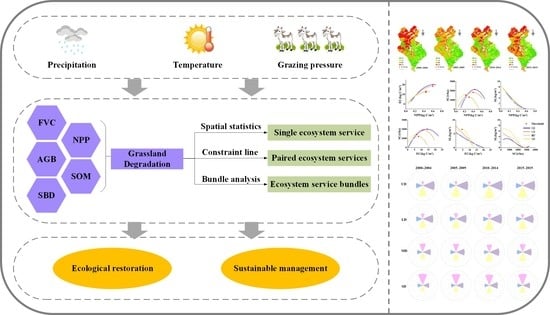A Perspective on the Impact of Grassland Degradation on Ecosystem Services for the Purpose of Sustainable Management
Abstract
1. Introduction
2. Materials and Methods
2.1. Study Area
2.2. Research Framework
2.3. Data Sources
2.4. Models and Methods
2.4.1. Integrating Monitoring of Grassland Degradation
2.4.2. Quantification of Ecosystem Services
2.4.3. Analytical Methods
- (1)
- Spatial simulation of grazing pressure
- (2)
- Constraint lines
- (3)
- Analysis of environmental impact
3. Results
3.1. Spatiotemporal Distribution Characteristics
3.1.1. Grassland Degradation
3.1.2. Ecosystem Services
3.2. Impacts of Grassland Degradation on Ecosystem Services
3.2.1. Single Ecosystem Service
3.2.2. Paired Ecosystem Services
3.2.3. Ecosystem Service Bundles
3.3. Impacts of Climate Change and Grazing Pressure on Grassland Degradation and Ecosystem Services
3.3.1. Grassland Degradation
3.3.2. Ecosystem Services
3.3.3. Relationship between Grassland Degradation and Ecosystem Services
4. Discussion
4.1. Grassland Degradation and Ecosystem Services
4.1.1. Impacts of Grassland Degradation on Ecosystem Services
4.1.2. Relational Network of “Climate Change and Grazing Pressure-Grassland Degradation-Ecosystem Services”
4.2. Ecological Restoration and Sustainable Management
4.2.1. Identifying the Priorities of Regional Governance
4.2.2. Improving Ecological Engineering Measures
4.2.3. Defining the Red Line for Ecological Protection
4.2.4. Identification of Ecological Engineering Zones
4.3. Limitations and Future Research Directions
5. Conclusions
Supplementary Materials
Author Contributions
Funding
Data Availability Statement
Conflicts of Interest
References
- Wang, B.; Yan, H.; Wen, X.; Niu, Z. Satellite-Based Monitoring on Green-Up Date for Optimizing the Rest-Grazing Period in Xilin Gol Grassland. Remote Sens. 2022, 14, 3443. [Google Scholar] [CrossRef]
- Lyu, X.; Li, X.; Wang, H.; Gong, J.; Li, S.; Dou, H.; Dang, D. Soil wind erosion evaluation and sustainable management of typical steppe in Inner Mongolia, China. J. Environ. Manage. 2021, 277, 111488. [Google Scholar] [CrossRef] [PubMed]
- Wang, C.; Wei, M.; Wu, B.; Wang, S.; Jiang, K. Alpine grassland degradation reduced plant species diversity and stability of plant communities in the Northern Tibet Plateau. Acta Oecologica. 2019, 98, 25–29. [Google Scholar] [CrossRef]
- Hu, A.; Millner, J.; Hou, F. Introduction of woody and herbaceous legumes influences productivity, diversity and soil properties in a degraded grassland. Land Degrad. Dev. 2021, 32, 3762–3772. [Google Scholar] [CrossRef]
- Zong, N.; Shi, P.; Zheng, L.; Zhou, T.; Cong, N.; Hou, G.; Song, M.; Tian, J.; Zhang, X.; Zhu, J. Restoration effects of fertilization and grazing exclusion on different degraded alpine grasslands: Evidence from a 10-year experiment. Ecol. Eng. 2021, 170, 106361. [Google Scholar] [CrossRef]
- Miehe, G.; Schleuss, P.-M.; Seeber, E.; Babel, W.; Biermann, T.; Braendle, M.; Chen, F.; Coners, H.; Foken, T.; Gerken, T.; et al. The Kobresia pygmaea ecosystem of the Tibetan highlands–Origin, functioning and degradation of the world’s largest pastoral alpine ecosystem: Kobresia pastures of Tibet. Sci. Total Environ. 2019, 648, 754–771. [Google Scholar] [CrossRef] [PubMed]
- Zhang, X.; Niu, J.; Buyantuev, A.; Zhang, Q.; Dong, J.; Kang, S.; Zhang, J. Understanding Grassland Degradation and Restoration from the Perspective of Ecosystem Services: A Case Study of the Xilin River Basin in Inner Mongolia, China. Sustainability 2016, 8, 594. [Google Scholar] [CrossRef]
- Wen, L.; Dong, S.; Li, Y.; Li, X.; Shi, J.; Wang, Y.; Liu, D.; Ma, Y. Effect of degradation intensity on grassland ecosystem services in the alpine region of Qinghai-Tibetan Plateau, China. PLoS ONE 2013, 8, e58432. [Google Scholar] [CrossRef] [PubMed]
- Wang, Z.; Ma, Y.; Zhang, Y.; Shang, J. Review of Remote Sensing Applications in Grassland Monitoring. Remote Sens. 2022, 14, 2903. [Google Scholar] [CrossRef]
- Lyu, X.; Li, X.; Gong, J.; Wang, H.; Dang, D.; Dou, H.; Li, S.; Liu, S. Comprehensive grassland degradation monitoring by remote sensing in Xilinhot, Inner Mongolia, China. Sustainability 2020, 12, 3682. [Google Scholar] [CrossRef]
- Schirpke, U.; Kohler, M.; Leitinger, G.; Fontana, V.; Tasser, E.; Tappeiner, U. Future impacts of changing land-use and climate on ecosystem services of mountain grassland and their resilience. Ecosyst. Serv. 2017, 26, 79–94. [Google Scholar] [CrossRef]
- Lavorel, S.; Colloff, M.J.; Locatelli, B.; Gorddard, R.; Prober, S.M.; Gabillet, M.; Devaux, C.; Laforgue, D.; Peyrache-Gadeau, V. Mustering the power of ecosystems for adaptation to climate change. Environ. Sci. Policy 2019, 92, 87–97. [Google Scholar] [CrossRef]
- Jäger, H.; Peratoner, G.; Tappeiner, U.; Tasser, E. Grassland biomass balance in the European Alps: Current and future ecosystem service perspectives. Ecosyst. Serv. 2020, 45, 101163. [Google Scholar] [CrossRef]
- Zhang, G.; Yan, J.; Zhu, X.; Ling, H.; Xu, H. Spatio-temporal variation in grassland degradation and its main drivers, based on biomass: Case study in the Altay Prefecture, China. Glob. Ecol. Conserv. 2019, 20, e00723. [Google Scholar] [CrossRef]
- Underwood, E.; Hollander, A.; Safford, H.; Kim, J.; Srivastava, L.; Drapek, R. The impacts of climate change on ecosystem services in southern California. Ecosyst. Serv. 2019, 39, 101008. [Google Scholar] [CrossRef]
- Talukdar, S.; Singha, P.; Shahfahad; Mahato, S.; Praveen, B.; Rahman, A. Dynamics of ecosystem services (ESs) in response to land use land cover (LULC) changes in the lower Gangetic plain of India. Ecol. Indic. 2020, 112, 106121. [Google Scholar] [CrossRef]
- Fan, F.; Liang, C.; Tang, Y.; Harker-Schuch, I.; Porter, J.R. Effects and relationships of grazing intensity on multiple ecosystem services in the Inner Mongolian steppe. Sci. Total Environ. 2019, 675, 642–650. [Google Scholar] [CrossRef] [PubMed]
- Nakano, T.; Bavuudorj, G.; Iijima, Y.; Ito, T.Y. Quantitative evaluation of grazing effect on nomadically grazed grassland ecosystems by using time-lapse cameras. Agric. Ecosyst Environ. 2020, 287, 106685. [Google Scholar] [CrossRef]
- Holling, C.S. Resilience and stability of ecological systems. Ann. Rev. Ecol. Syst. 1973, 4, 1–23. [Google Scholar] [CrossRef]
- Xu, J.; Grumbine, R.E. Building ecosystem resilience for climate change adaptation in the Asian highlands. Wires Clim. Change 2014, 5, 709–718. [Google Scholar] [CrossRef]
- Hodgson, D.; McDonald, J.; Hosken, D. What do you mean, ‘resilient’? Trends Ecol. Evol. 2015, 30, 503–506. [Google Scholar] [CrossRef]
- Gongbuzeren; Huntsinger, L.; Li, W. Rebuilding pastoral social-ecological resilience on the Qinghai-Tibetan Plateau in response to changes in policy, economics, and climate. Ecol. Soc. 2018, 23, 2. [Google Scholar] [CrossRef]
- Strassburg, B.B.N.; Beyer, H.L.; Crouzeilles, R.; Iribarrem, A.; Barros, F.; de Siqueira, M.F.; Sánchez-Tapia, A.; Balmford, A.; Sansevero, J.B.B.; Brancalion, P.H.S.; et al. Strategic approaches to restoring ecosystems can triple conservation gains and halve costs. Nat. Ecol. Evol. 2019, 3, 62–70. [Google Scholar] [CrossRef] [PubMed]
- Lang, Y.; Yang, X.; Cai, H. Assessing the degradation of grassland ecosystems based on the advanced local net production scaling method—The case of Inner Mongolia, China. Land Degrad. Dev. 2021, 32, 559–572. [Google Scholar] [CrossRef]
- Lu, Q.; Xu, B.; Liang, F.; Gao, Z.; Ning, J. Influences of the Grain-for-Green project on grain security in southern China. Ecol. Indic. 2013, 34, 616–622. [Google Scholar] [CrossRef]
- Ren, Y.; Lu, Y.; Fu, B. Quantifying the impacts of grassland restoration on biodiversity and ecosystem services in China: A meta-analysis. Ecol. Eng. 2016, 95, 542–550. [Google Scholar] [CrossRef]
- Liu, Z.; Wang, J.; Wang, X.; Wang, Y. Understanding the impacts of ‘Grain for Green’ land management practice on land greening dynamics over the Loess Plateau of China. Land Use Policy 2020, 99, 105084. [Google Scholar] [CrossRef]
- Zheng, X.; Zhang, J.; Cao, S. Net value of grassland ecosystem services in mainland China. Land Use Policy 2018, 79, 94–101. [Google Scholar] [CrossRef]
- Moreno-Mateos, D.; Alberdi, A.; Morriën, E.; van der Putten, W.H.; Rodríguez-Uña, A.; Montoya, D. The long-term restoration of ecosystem complexity. Nat. Ecol. Evol. 2020, 4, 676–685. [Google Scholar] [CrossRef]
- Strassburg, B.B.N.; Iribarrem, A.; Beyer, H.L.; Cordeiro, C.L.; Crouzeilles, R.; Jakovac, C.C.; Braga, J.A.; Lacerda, E.; Latawiec, A.E.; Balmford, A.; et al. Global priority areas for ecosystem restoration. Nature 2020, 586, 724–729. [Google Scholar] [CrossRef]
- Batunacun; Ralf, W.; Tobia, L.; Hu, Y.; Claas, N. Identifying drivers of land degradation in Xilingol, China, between 1975 and 2015. Land Use Policy 2019, 83, 543–559. [Google Scholar] [CrossRef]
- Zhao, Y.; Zhang, Q.; Li, Y. Patterns and drivers of household carbon footprint of the herdsmen in the typical steppe region of inner Mongolia, China: A case study in Xilinhot City. J. Clean. Prod. 2019, 232, 408–416. [Google Scholar] [CrossRef]
- Wang, H.; Hu, Y.; Yan, H.; Liang, Y.; Guo, X.; Ye, J. Trade-off among grain production, animal husbandry production, and habitat quality based on future scenario simulations in Xilinhot. Sci. Total Environ. 2022, 817, 153015. [Google Scholar] [CrossRef] [PubMed]
- Brookshire, E.N.J.; Weaver, T. Long-term decline in grassland productivity driven by increasing dryness. Nat. Commun. 2015, 6, 7148. [Google Scholar] [CrossRef] [PubMed]
- Hufkens, K.; Keenan, T.F.; Flanagan, L.B.; Scott, R.L.; Bernacchi, C.J.; Joo, E.; Brunsell, N.A.; Verfaillie, J.; Richardson, A.D. Productivity of North American grasslands is increased under future climate scenarios despite rising aridity. Nat. Clim. Change 2016, 6, 710–714. [Google Scholar] [CrossRef]
- Li, Y.; Dong, S.; Wen, L.; Wang, X.; Wu, Y. Soil carbon and nitrogen pools and their relationship to plant and soil dynamics of degraded and artificially restored grasslands of the Qinghai–Tibetan Plateau. Geoderma 2014, 213, 178–184. [Google Scholar] [CrossRef]
- Gao, X.; Dong, S.; Xu, Y.; Wu, S.; Wu, X.; Zhang, X.; Zhi, Y.; Li, S.; Liu, S.; Li, Y.; et al. Resilience of revegetated grassland for restoring severely degraded alpine meadows is driven by plant and soil quality along recovery time: A case study from the Three-river Headwater Area of Qinghai-Tibetan Plateau. Agric. Ecosyst. Environ. 2019, 279, 169–177. [Google Scholar] [CrossRef]
- Xu, Y.; Dong, S.; Gao, X.; Yang, M.; Li, S.; Shen, H.; Xiao, J.; Han, Y.; Zhang, J.; Li, Y.; et al. Trade-offs and cost-benefit of ecosystem services of revegetated degraded alpine meadows over time on the Qinghai-Tibetan Plateau. Agric. Ecosyst. Environ. 2019, 279, 130–138. [Google Scholar] [CrossRef]
- Potter, C.; Randerson, J.; Field, C.; Matson, P.; Vitousek, P.; Mooney, H.; Klooster, S. Terrestrial ecosystem production: A process model based on global satellite and surface data. Glob. Biogeochem. Cycles 1993, 7, 811–841. [Google Scholar] [CrossRef]
- Wang, Z.; Zhang, Y.; Yang, Y.; Zhou, W.; Gang, C.; Zhang, Y.; Li, J.; An, R.; Wang, K.; Odeh, I.; et al. Quantitative assess the driving forces on the grassland degradation in the Qinghai-Tibet Plateau, in China. Ecol. Inform. 2016, 33, 32–44. [Google Scholar] [CrossRef]
- Barrett, D.J. Steady state turnover time of carbon in the Australian terrestrial biosphere. Glob. Biogeochem. Cycles 2002, 16, 1108. [Google Scholar]
- Yang, B.; Gong, J.; Zhang, Z.; Wang, B.; Zhu, C.; Shi, J.; Liu, M.; Liu, Y.; Li, X. Stabilization of carbon sequestration in a Chinese desert steppe benefits from increased temperatures and from precipitation outside the growing season. Sci. Total Environ. 2019, 691, 263–277. [Google Scholar] [CrossRef]
- Renard, K.; Foster, G.; Weesies, G.; Porter, J. RUSLE: Revised universal soil loss equation. J. Soil. Water. Conserv. 1991, 46, 30–33. [Google Scholar]
- Li, S.; Li, X.; Dou, H.; Dang, D.; Gong, J. Integrating constraint effects among ecosystem services and drivers on seasonal scales into management practices. Ecol. Indic. 2021, 125, 107425. [Google Scholar] [CrossRef]
- Fryrear, D.; Saleh, A.; Bilbro, J. A single event wind erosion model. T. ASABE 1998, 41, 1369–1374. [Google Scholar] [CrossRef]
- Zhu, W.; Pan, Y.; Zhang, J. Estimation of net primary productivity of Chinese terrestrial vegetation based on remote sensing. J. Plant Ecol. 2007, 31, 413–424. [Google Scholar]
- Zhou, T.; Shi, P.; Luo, J.; Shao, Z. Estimation of soil organic carbon based on remote sensing and process model. Front. For. China 2008, 3, 139–147. [Google Scholar] [CrossRef]
- Zhou, T.; Shi, P.; Jia, G.; Li, X.; Luo, Y. Spatial patterns of ecosystem carbon residence time in Chinese forests. Sci. China Earth Sci. 2010, 53, 1229–1240. [Google Scholar] [CrossRef]
- Li, G.; Li, X.; Zhou, T.; Wang, H.; Li, R.; Wang, H.; Wei, D. A model for simulating the soil organic carbon pool of steppe ecosystems. Environ. Model. Assess. 2016, 21, 339–355. [Google Scholar]
- Lyu, X.; Li, X.; Dou, H.; Dang, D.; Li, S.; Li, X.; Li, M.; Liu, S. Evaluation of grassland carbon pool based on TECO-R model and climate-driving function: A case study in the Xilingol typical steppe region of Inner Mongolia, China. Ecol. Indic. 2020, 117, 106508. [Google Scholar] [CrossRef]
- Fu, B.; Liu, Y.; Lü, Y.; He, C.; Zeng, Y.; Wu, B. Assessing the soil erosion control service of ecosystems change in the Loess Plateau of China. Ecol. Complex. 2011, 8, 284–293. [Google Scholar] [CrossRef]
- Lü, Y.; Fu, B.; Feng, X.; Zeng, Y.; Liu, Y.; Chang, R.; Sun, G.; Wu, B. A policy-driven large scale ecological restoration: Quantifying ecosystem services changes in the Loess Plateau of China. PLoS ONE 2012, 7, e31782. [Google Scholar] [CrossRef] [PubMed]
- Wischmeier, W.H.; Smith, D.D. Predicting rainfall erosion losses-a guide to conservation planning; Agriculture handbook (United States. Dept. of Agriculture); no. 537; United States Department of Agriculture: Washington, DC, USA, 1978. [Google Scholar]
- Sharpley, A.N.; Williams, J.R. EPIC-erosion/productivity impact calculator: 1. Model determination; Technical Bulletin Number 1768; United States Department of Agriculture: Washington, DC, USA, 1990. [Google Scholar]
- Zhang, K.L.; Shu, A.P.; Xu, X.L.; Yang, Q.K.; Yu, B. Soil erodibility and its estimation for agricultural soils in China. J. Arid Environ. 2008, 72, 1002–1011. [Google Scholar] [CrossRef]
- Mccool, D.K.; Foster, G.R.; Mutchler, C.K.; Meyer, L.D. Revised slope length factor for the Universal Soil Loss Equation. T. ASABE 1989, 32, 1571–1576. [Google Scholar] [CrossRef]
- Liu, B.; Nearing, M.A.; Shi, P.; Jia, Z. Slope length effects on soil loss for steep slopes. Soil Sci. Soc. Am. J. 1994, 64, 1759–1763. [Google Scholar] [CrossRef]
- Cai, C.; Ding, S.; Shi, Z.; Huang, L.; Zhang, G. Study of applying USLE and geographical information system IDRISI to predict soil erosion in small watershed. J. Soil Water Conserv. 2000, 14, 19–24. [Google Scholar]
- Jia, X.; Fu, B.; Feng, X.; Hou, G.; Liu, Y.; Wang, X. The tradeoff and synergy between ecosystem services in the Grain-for-Green areas in Northern Shaanxi, China. Ecol. Indic. 2014, 43, 103–113. [Google Scholar] [CrossRef]
- Van Pelt, R.S.; Zobeck, T.M.; Potter, K.N.; Stout, J.E.; Popham, T.W. Validation of the wind erosion stochastic simulator (WESS) and the revised wind erosion equation (RWEQ) for single events. Environ. Modell. Softw. 2004, 19, 191–198. [Google Scholar] [CrossRef]
- Fu, Q.; Li, B.; Hou, Y.; Bi, X.; Zhang, X. Effects of land use and climate change on ecosystem services in Central Asia’s arid regions: A case study in Altay Prefecture, China. Sci. Total Environ. 2017, 607–608, 633–646. [Google Scholar] [CrossRef]
- Jiang, C.; Nath, R.; Labzovskii, L.; Wang, D. Integrating ecosystem services into effectiveness assessment of ecological restoration program in northern China’s arid areas: Insights from the Beijing-Tianjin Sandstorm Source Region. Land Use Policy 2018, 75, 201–214. [Google Scholar] [CrossRef]
- Gong, G.; Liu, J.; Shao, Q. Wind erosion in Xilingol League, Inner Mongolia since the 1990s using the revised wind erosion equation. Prog. Geogr. 2014, 33, 825–834. [Google Scholar]
- Fryrcar, D.W.; Chen, W.N.; Lester, C. Revised Wind Erosion Equation. Ann. Arid Zone 2001, 40, 265–279. [Google Scholar]
- Guo, Z.; Zobeck, T.M.; Zhang, K.; Li, F. Estimating potential wind erosion of agricultural lands in northern China using the Revised Wind Erosion Equation and geographic information systems. J. Soil Water Conserv. 2013, 68, 13–21. [Google Scholar] [CrossRef]
- Chi, D.; Wang, H.; Li, X.; Liu, H.; Li, X. Assessing the effects of grazing on variations of vegetation NPP in the Xilingol Grassland, China, using a grazing pressure index. Ecol. Indic. 2018, 88, 372–383. [Google Scholar] [CrossRef]
- Li, X.; Lyu, X.; Dou, H.; Dang, D.; Li, S.; Li, X.; Li, M.; Xuan, X. Strengthening grazing pressure management to improve grassland ecosystem services. Glob. Ecol. Conserv. 2021, 31, e01782. [Google Scholar] [CrossRef]
- Mills, A.J.; Fey, M.V.; Grongroft, A.; Petersen, A.; Medinski, T.V. Unravelling the effects of soil properties on water infiltration: Segmented quantile regression on a large data set from arid south-west Africa. Aust. J. Soil Res. 2006, 44, 783–797. [Google Scholar] [CrossRef]
- Hao, R.; Yu, D.; Wu, J. Relationship between paired ecosystem services in the grassland and agro-pastoral transitional zone of China using the constraint line method. Agric. Ecosyst. Environ. 2017, 240, 171–181. [Google Scholar] [CrossRef]
- Hao, R.; Yu, D.; Sun, Y.; Shi, M. The features and influential factors of interactions among ecosystem services. Ecol. Indic. 2019, 101, 770–779. [Google Scholar] [CrossRef]
- Dong, S.; Sherman, R. Enhancing the resilience of coupled human and natural systems of alpine rangelands on the Qinghai-Tibetan Plateau. Rangeland. J. 2015, 37, 1. [Google Scholar] [CrossRef]
- Wen, X.; Deng, X.; Zhang, F. Scale effects of vegetation restoration on soil and water conservation in a semi-arid region in China: Resources conservation and sustainable management. Resour. Conserv. Recycl. 2019, 151, 104474. [Google Scholar] [CrossRef]
- Löbmann, M.T.; Tonin, R.; Stegemann, J.; Zerbe, S.; Geitner, C.; Mayr, A.; Wellstein, C. Towards a better understanding of shallow erosion resistance of subalpine grasslands. J. Environ. Manage. 2020, 276, 111267. [Google Scholar] [CrossRef] [PubMed]
- Lin, S.; Wu, R.; Yang, F.; Wang, J.; Wu, W. Spatial trade-offs and synergies among ecosystem services within a global biodiversity hotspot. Ecol. Indic. 2018, 84, 371–381. [Google Scholar] [CrossRef]
- Dou, H.; Li, X.; Li, S.; Dang, D.; Li, X.; Lyu, X.; Li, M.; Liu, S. Mapping ecosystem services bundles for analyzing spatial trade-offs in inner Mongolia, China. J. Clean. Prod. 2020, 256, 120444. [Google Scholar] [CrossRef]
- Hu, Y.; Huang, J.; Hou, L. Impacts of the Grassland Ecological Compensation Policy on Household Livestock Production in China: An Empirical Study in Inner Mongolia. Ecol. Econ. 2019, 161, 248–256. [Google Scholar] [CrossRef]
- Zhang, Y.; Guan, D.; Wu, L.; Su, X.; Zhou, L.; Peng, G. How can an ecological compensation threshold be determined? A discriminant model integrating the minimum data approach and the most appropriate land use scenarios. Sci. Total Environ. 2022, 852, 158377. [Google Scholar] [CrossRef] [PubMed]
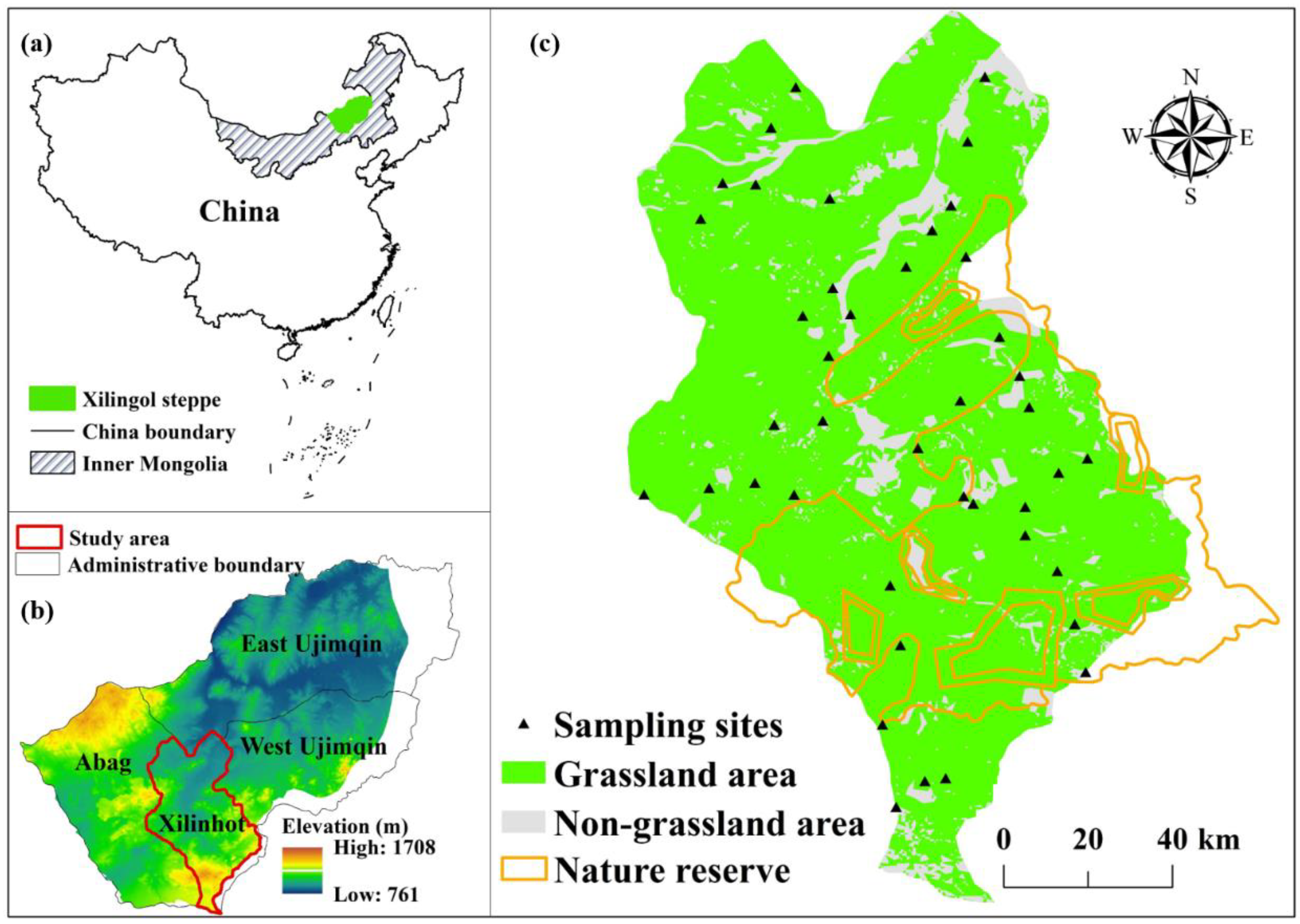
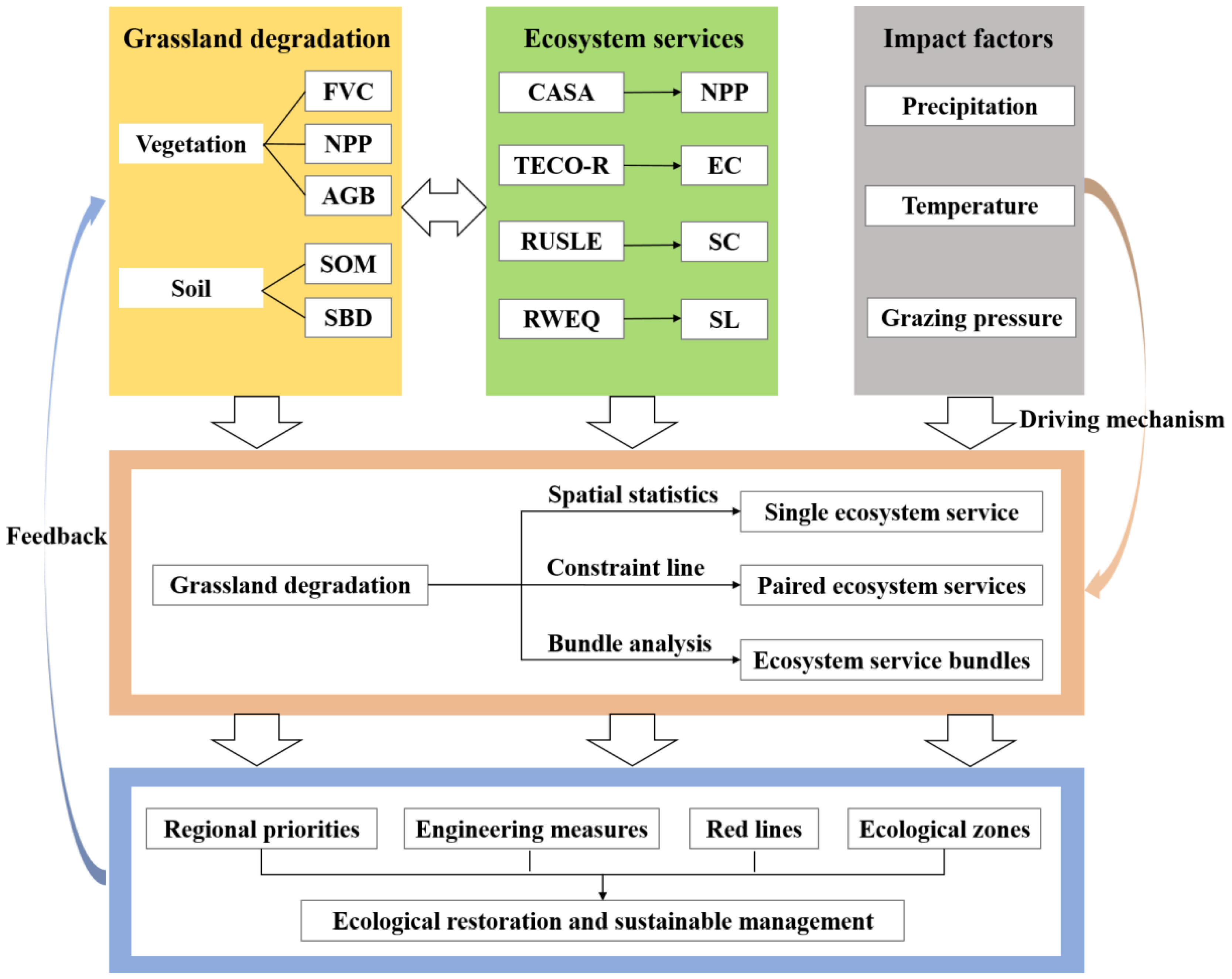
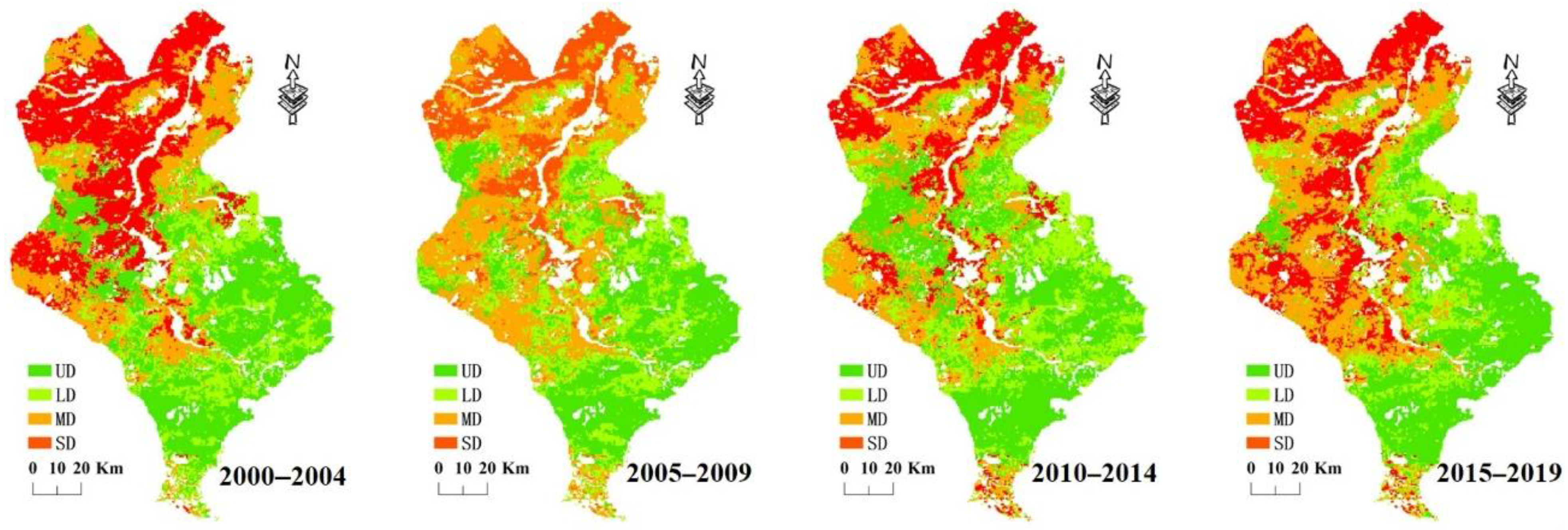
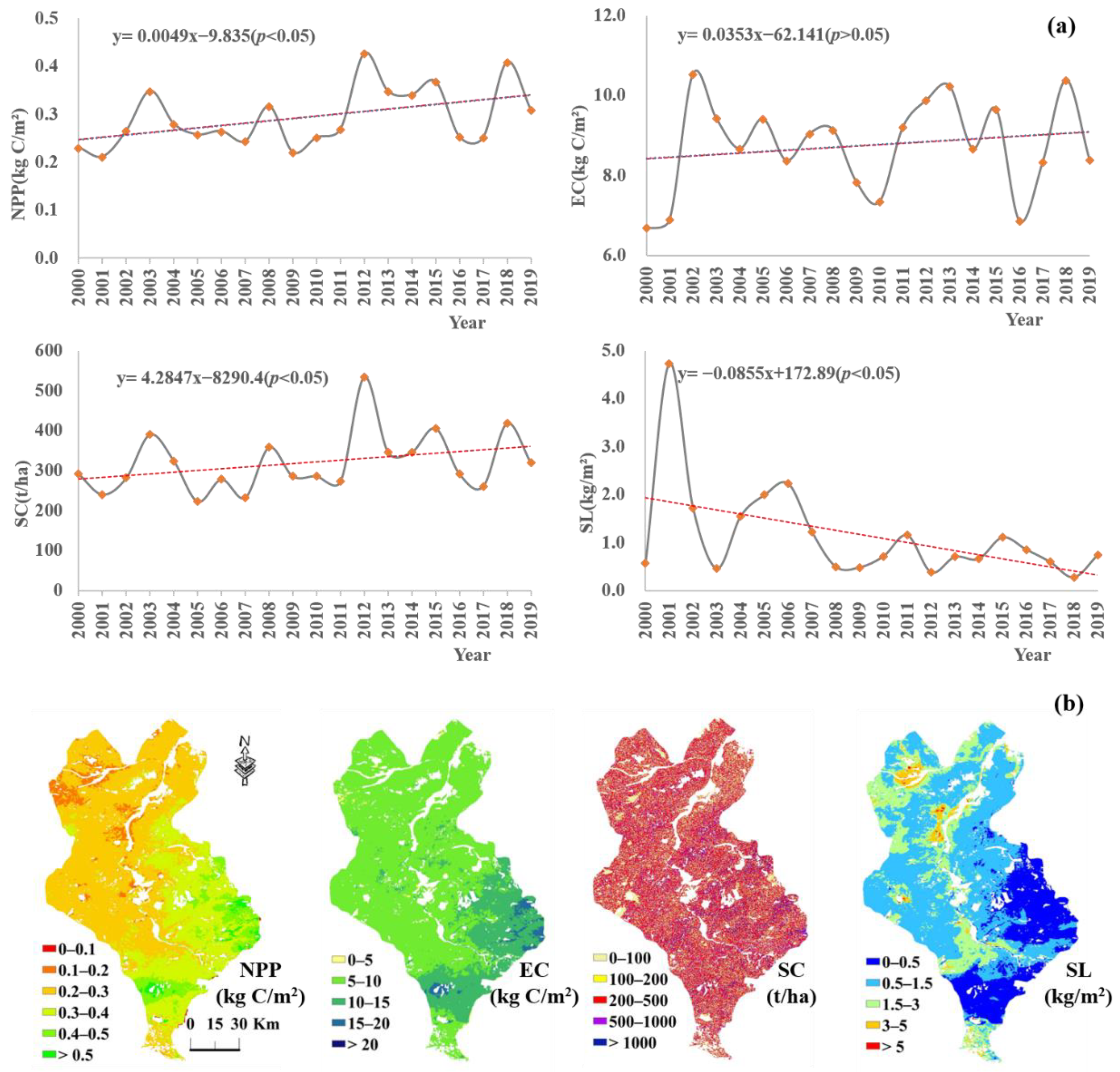
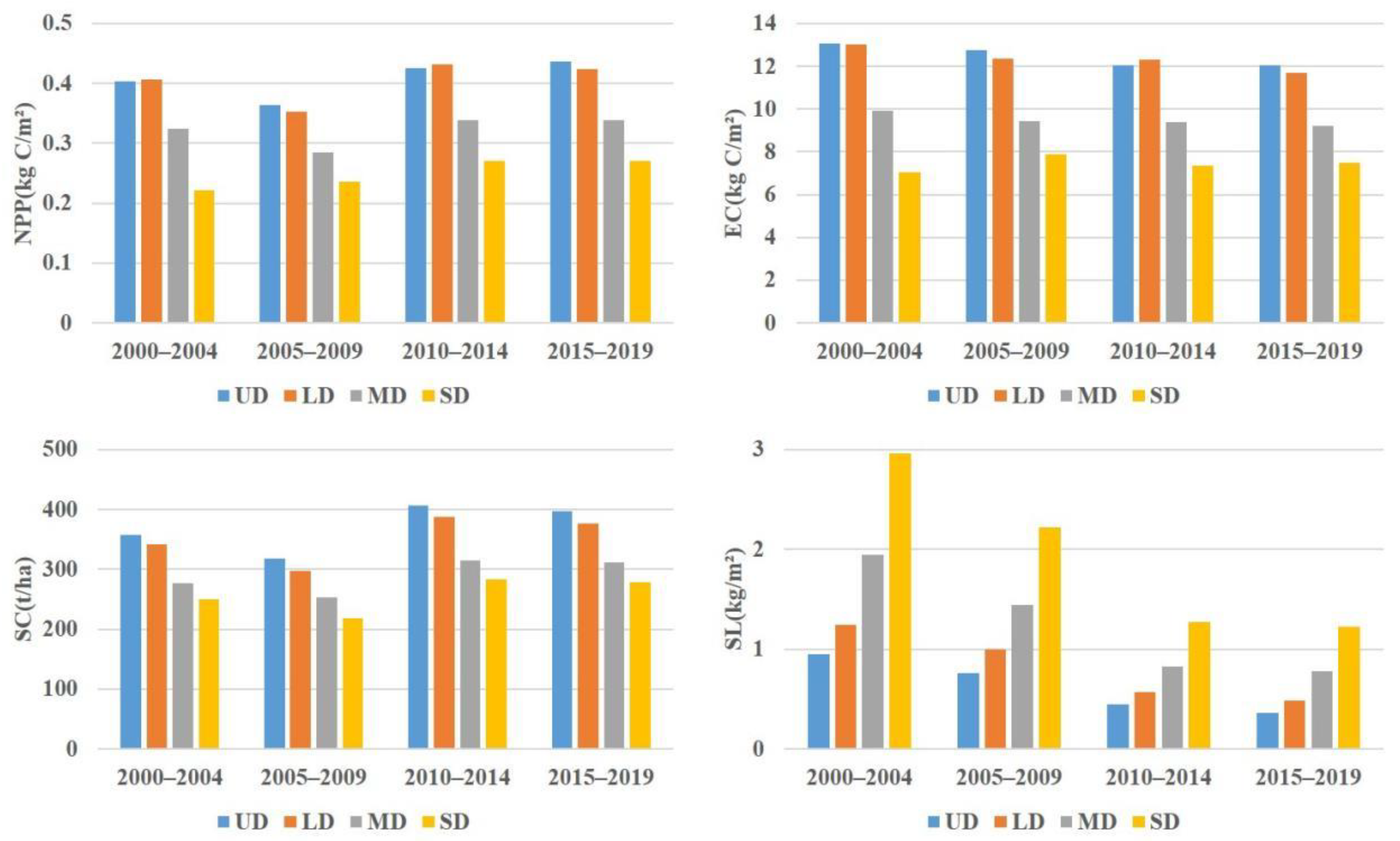
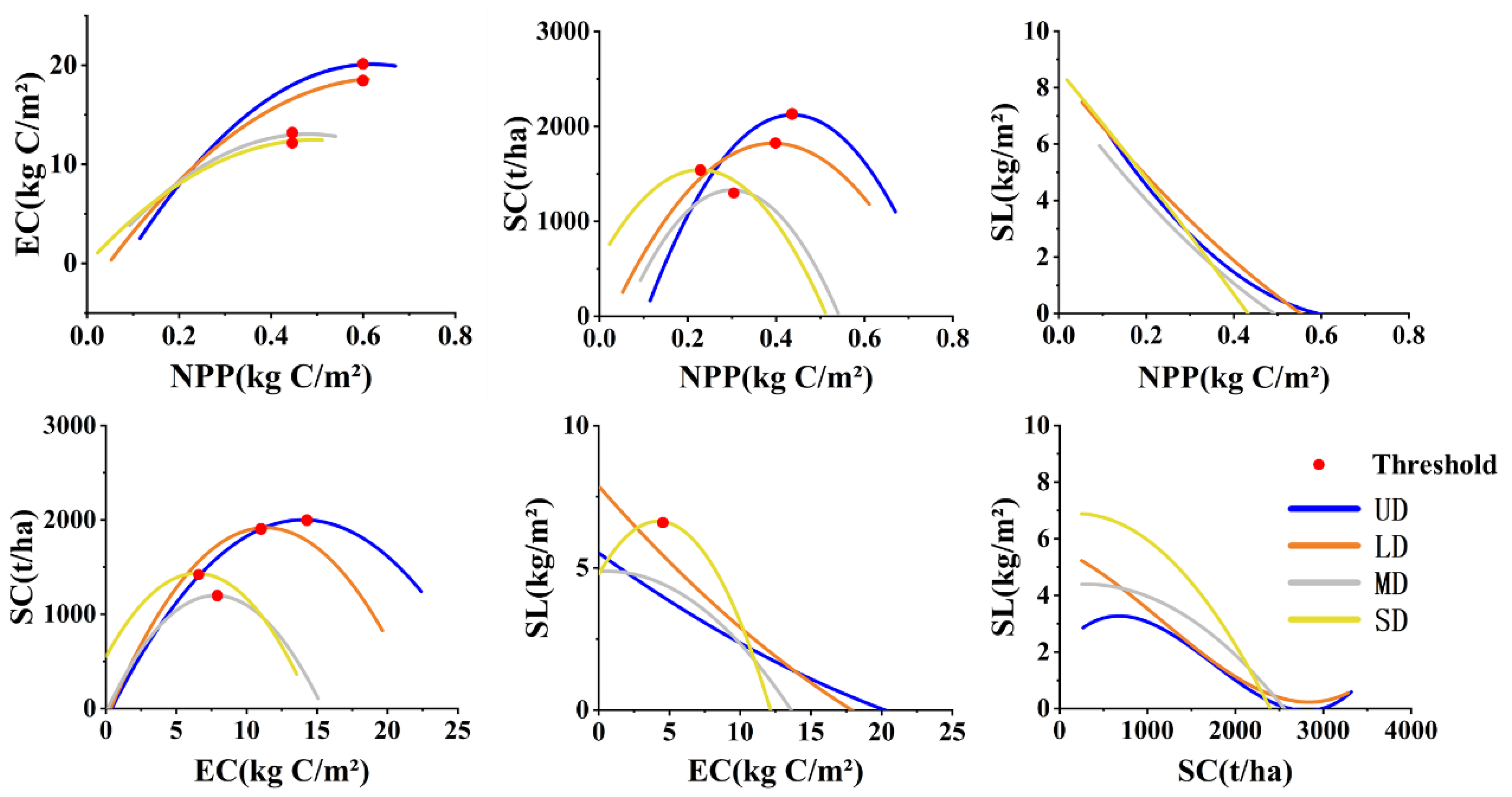



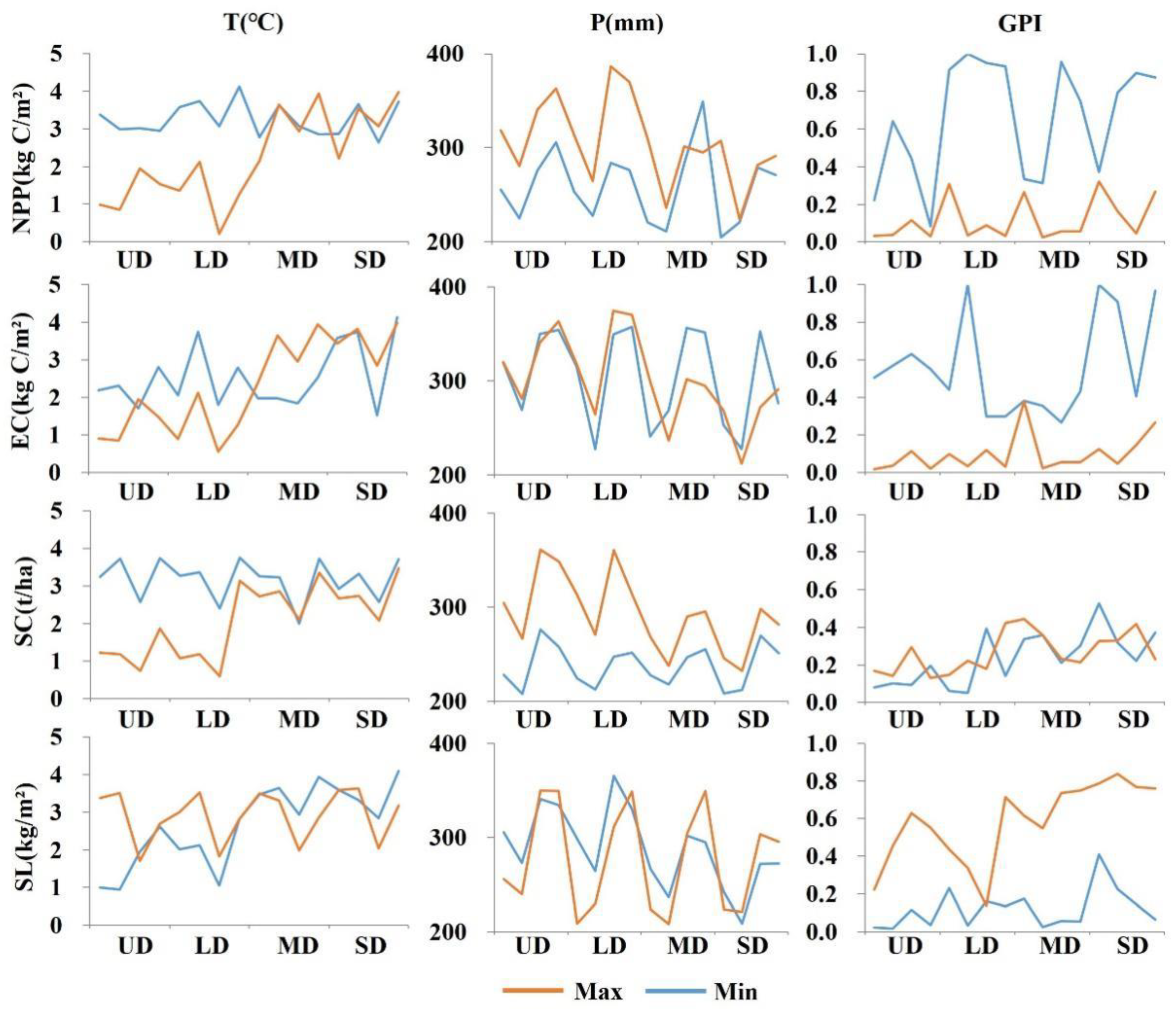
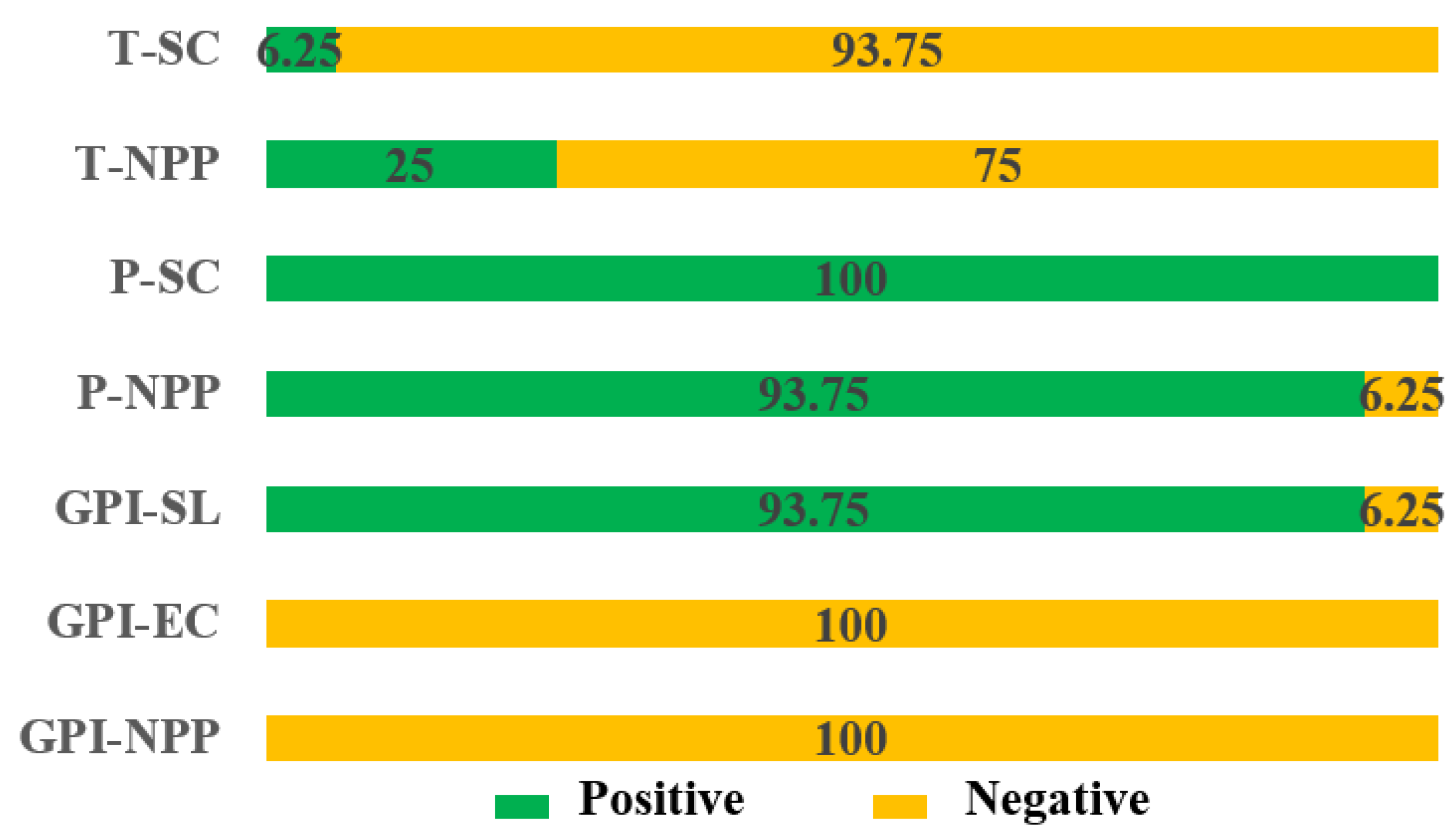
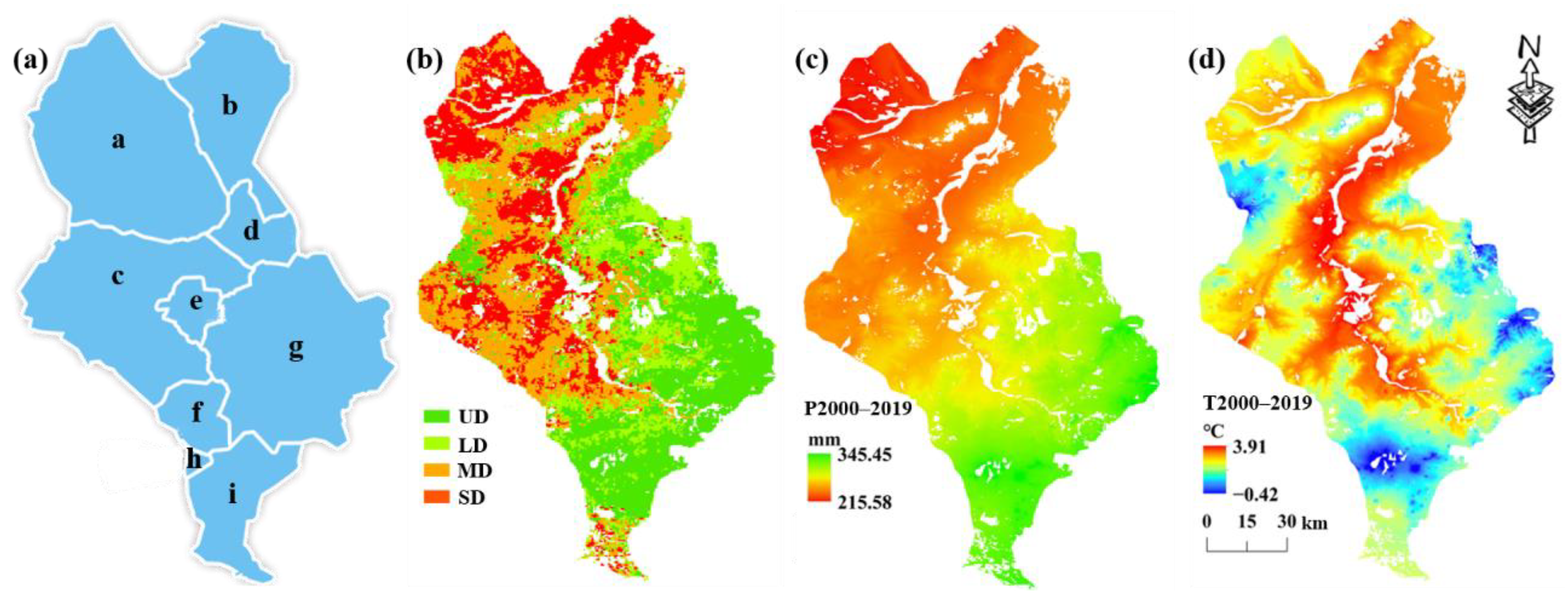
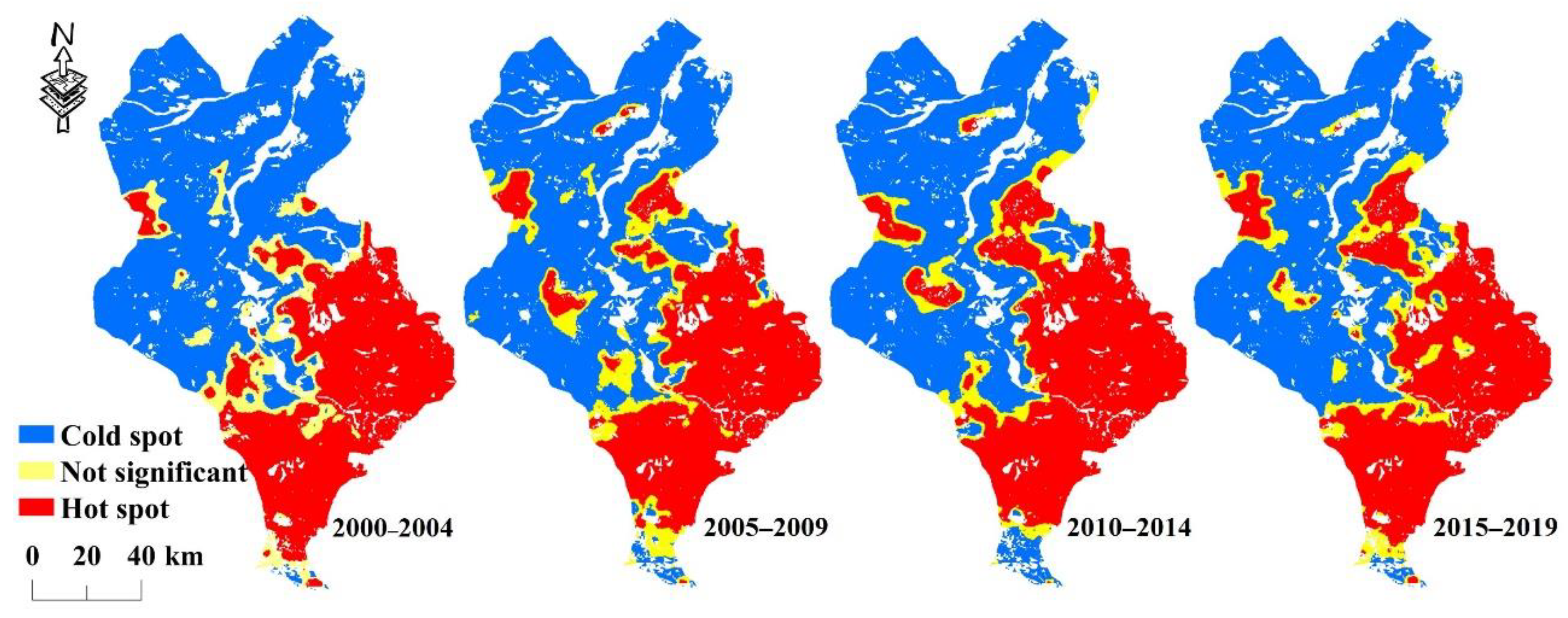
| Type | Description | Spatial Resolution | Source |
|---|---|---|---|
| Remote sensing data | MOD13Q1 | 250 m | NASA (https://www.nasa.gov/, accessed on 10 February 2020) |
| Vegetation data | Vegetation-type map | 1 km | Resource and Environment Science and Data Center (http://www.resdc.cn/, accessed on 10 February 2020) |
| Soil data | Soil-type map | 1 km | Resource and Environment Science and Data Center (http://www.resdc.cn/, accessed on 20 March 2020) |
| Meteorological data | Monthly temperature | 250 m | China Meteorological Sharing Service System (http://data.cma.cn/, accessed on 12 May 2020) |
| Monthly precipitation | 250 m | ||
| Monthly radiation | 250 m | ||
| Basic data | STRM | 90 m | Geospatial Data Cloud (http://www.gscloud.cn/, accessed on 10 January 2020) |
| Land use-cover change | 30 m | Resource and Environment Science and Data Center (http://www.resdc.cn/, accessed on 20 March 2020) | |
| Border vector map | N/A | National Geomatics Center of China (http://www.ngcc.cn/ngcc/, accessed on 25 January 2020) | |
| Nature Reserve | N/A | National Forestry and Grassland Administration of China |
| Proportion (%) | 2000–2004 | 2005–2009 | 2010–2014 | 2015–2019 |
|---|---|---|---|---|
| UD | 31.5 | 29.3 | 34.5 | 29.3 |
| LD | 16.9 | 22.3 | 22.5 | 17.4 |
| MD | 22.8 | 31.0 | 24.3 | 29.1 |
| SD | 28.8 | 17.4 | 18.7 | 24.2 |
| UD | LD | MD | SD | |
|---|---|---|---|---|
| T-SC | 0.28 | 0.21 | 0.01 | 0.01 |
| T-NPP | 0.22 | 0.39 | 0.01 | 0.01 |
| P-SC | 0.19 | 0.21 | 0.04 | 0.03 |
| P-NPP | 0.11 | 0.18 | 0.09 | 0.08 |
| GPI-SL | 0.20 | 0.16 | 0.37 | 0.36 |
| GPI-EC | 0.28 | 0.30 | 0.08 | 0.53 |
| GPI-NPP | 0.13 | 0.74 | 0.36 | 0.39 |
Publisher’s Note: MDPI stays neutral with regard to jurisdictional claims in published maps and institutional affiliations. |
© 2022 by the authors. Licensee MDPI, Basel, Switzerland. This article is an open access article distributed under the terms and conditions of the Creative Commons Attribution (CC BY) license (https://creativecommons.org/licenses/by/4.0/).
Share and Cite
Lyu, X.; Li, X.; Dang, D.; Dou, H.; Wang, K.; Gong, J.; Wang, H.; Liu, S. A Perspective on the Impact of Grassland Degradation on Ecosystem Services for the Purpose of Sustainable Management. Remote Sens. 2022, 14, 5120. https://doi.org/10.3390/rs14205120
Lyu X, Li X, Dang D, Dou H, Wang K, Gong J, Wang H, Liu S. A Perspective on the Impact of Grassland Degradation on Ecosystem Services for the Purpose of Sustainable Management. Remote Sensing. 2022; 14(20):5120. https://doi.org/10.3390/rs14205120
Chicago/Turabian StyleLyu, Xin, Xiaobing Li, Dongliang Dang, Huashun Dou, Kai Wang, Jirui Gong, Hong Wang, and Shiliang Liu. 2022. "A Perspective on the Impact of Grassland Degradation on Ecosystem Services for the Purpose of Sustainable Management" Remote Sensing 14, no. 20: 5120. https://doi.org/10.3390/rs14205120
APA StyleLyu, X., Li, X., Dang, D., Dou, H., Wang, K., Gong, J., Wang, H., & Liu, S. (2022). A Perspective on the Impact of Grassland Degradation on Ecosystem Services for the Purpose of Sustainable Management. Remote Sensing, 14(20), 5120. https://doi.org/10.3390/rs14205120







